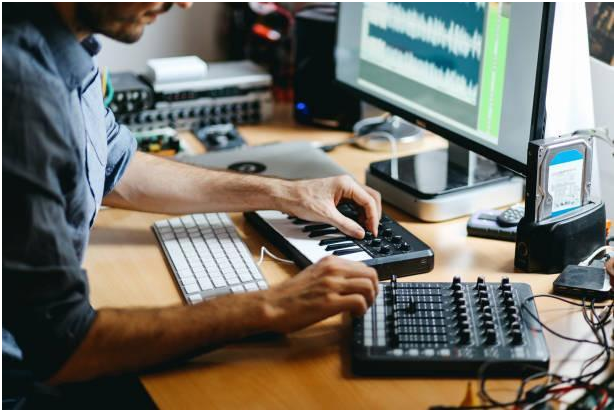The music industry's evolution throughout the decades is a testament to how technology can change the world.
Technology has been at the center of transforming the music we listen to today, leading to memorable beats, alluring tracks, and resonating lyrics. This can't be said about music in the pre-1960s, in which the content would fade quickly, and music lovers would be back desiring more.
Today, with the capabilities of MIDI, a track can have lasting effects, sometimes lasting for more than two decades. Thinks of the songs produced by artists in the early 2000s that still have some emotional appeal to date.
MIDI controllers are central to some of the best and nearly all the tracks you listen to today. They are responsible for the amazing beats, resonating instrumentals, and some of the lyrics worth listening to repeatedly. Due to these effects, the music industry and MIDI controllers have been evolving rapidly to boost their significance in music production and make tracks more appealing.
Since most people anticipate the best music in the future, here are some ways in which MIDI controller guarantees and promises to fulfill such expectations.
Integrating MIDI into More Devices
MIDI is integral for producing some of the best sounds; hence, most manufacturers consider adding it to most music devices.
Integrating MIDI into devices helps producers reduce clutter by having a few systems in the studio. MIDI controllers can perform more than one role; hence, producers only need a few instruments for various sounds. Nowadays, most of the critical kits and devices you buy already have MIDI integrated.
For a while now, keyboards have been the most common devices fitted with MIDI capabilities. This is fast changing as other devices like pads, faders, knobs, pedals, drum kits; all have special types with MIDI.
Due to this rapid change, keyboard controller MIDI is improving with newer technologies to boost performance. The latest keyboard MIDI controllers have more capabilities and technologies than the previous generation. For instance, the latest MIDI keyboards have technologies like illuminated keys, more channels, ROLI studio and per-key pitch bend technologies.
In the future, nearly all musical instruments will have MIDI to reduce clutter and have the best music. As these devices are improved, it will be much easier for amateurs and independent artists to produce music without relying much on production studios. Some instruments and devices will have more presets to boost key and sound quality.
MIDI 2.0
If you have been involved in music production in the past decade, then you know the critical role of MIDI in music production. It has had the greatest impact and continues to ensure quality music. Perhaps it is one of the technologies that has transformed traditional instruments in the past decade into what we have to date.
As technology changes, so does MIDI, and soon, the world will launch MIDI 2.0. As announced in 2019, the implementation has been rather slow, but more news and impact are anticipated from its full implementation. It is still in the testing process, awaiting the official launch, and once it is here, anticipate some rapid evolution in sound quality.
By now it is inevitable that MIDI 2.0 will soon be launched, changing how music is produced, and from it, you should anticipate the best tracks. Even at the prototype stage, it promises functionalities like 256 MIDI channels, web-based integration, higher resolution, and backward-compatible applications.
With MIDI 2.0, a keyboard can be used for mass music production and events, eliminating the need for various keyboards. For instance, in functions like musical theaters and orchestra, you will only need one keyboard as the MIDI software and laptop can accurately coordinate the sounds.
With higher resolution, you will likely experience more fun and music booms. Headset manufacturers are creating some of the best devices to boost surrounding music capabilities and sound impacts. This experience would hit ceiling levels when the music is produced using MIDI 2.0.
Moreover, with the newly proposed MIDI channels, some instruments are expected to be obsolete; hence, music production will be cheaper as some redundant labor will be eliminated. This is good news for artists and producers.
Paring MPE with MIDI
Multidimensional Polyphonic Expansion (MPE) exists to help produce and improve the quality of tones and generate more sounds from one stroke, key and beat. The main goal of MPE is to help in reducing the size of musical instruments.
Imagine the keyboard or piano size in the 1960s; they were large, rugged, and occupied more space, and the sound quality was not the best. Compared to what we have today? The modern keyboards integrated with MIDI are smaller and will continue to be smaller to the extent that they can fit in a bag.
To ensure a small-sized instrument, the MPE optimized channels per note; hence, when paired with MIDI keyboards, you can play and hold down multiple keys with a single. With each stroke, you get different pitches, eliminating the need for bigger keyboards with more keys. You can either press harder, medium, or softer for different tones from one key. The same applies to MIDI drum kits and pads, where the intensity produces different sounds.
Digital instruments
Today, it is much easier to create music from your phone using different apps like keyboards. The music created may not be the best however, in the future, MIDI 2.0 will help revolutionize these apps. When using large devices like iPads, you can download MIDI keyboards and other instruments and then create music comfortably. You do not need complex instruments, however, for refinement, you can use more advanced MIDI controller devices.
Bottomline
The future of the music industry will be controlled with MIDI, especially MIDI 2.0. Technology can revolutionize musical instruments, making them smaller and multifunctional, reducing the cost and ease of music production.
Also, expect the musical technology to be cloud-based, i.e., digital apps and software operable on digital devices.




No comments:
Post a Comment